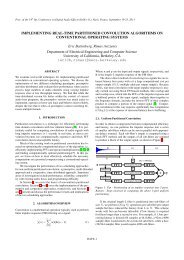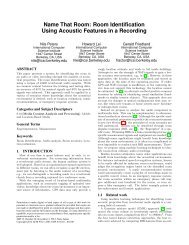Gestural Control of a Real-Time Physical Model of a Bowed String ...
Gestural Control of a Real-Time Physical Model of a Bowed String ...
Gestural Control of a Real-Time Physical Model of a Bowed String ...
You also want an ePaper? Increase the reach of your titles
YUMPU automatically turns print PDFs into web optimized ePapers that Google loves.
3 Bow Strokes<br />
The aim <strong>of</strong> our project is the real-time simulation <strong>of</strong><br />
highly skilled bowed string instrument performance.<br />
In particular, we are interested in studying the model's<br />
behaviour, when submitted to dierent bowstrokes,<br />
such asdetache, balzato, staccato, ying staccato ....<br />
The basic gestural parameters which can be used<br />
to dene bow strokes are: a specic precision grip in<br />
which all ve ngers are in contact with the bow, a<br />
variable length linear displacement in the axis <strong>of</strong> the<br />
bow, a rotational movement relative to the strings'<br />
axes in order to choose the string to be played,the<br />
pressure <strong>of</strong> the bow against the string and the bow<br />
velocity. Other important variables include the bow<br />
position relative to the string and the amount <strong>of</strong>bow<br />
hair in contact with the string, i.e., a rotation with<br />
respect to the bow's axis.<br />
One must also be aware that the technical demands<br />
required to preform many <strong>of</strong> these bow strokes<br />
are typically obtained by musicians only after years <strong>of</strong><br />
practice. Furthermore, in addition to the performer's<br />
skilled motor behaviour, these bow strokes heavily rely<br />
upon physical properties <strong>of</strong> both the string and the<br />
bow, such as the elasticity <strong>of</strong>thebow hair, tension <strong>of</strong><br />
the string, etc . . . .<br />
4 Choice <strong>of</strong> the Input <strong>Control</strong>ler<br />
In order to obtain an accurate simulation <strong>of</strong> the bow<br />
strokes mentioned above, it is necessary to haveaexible<br />
input controller at one's disposition. We have<br />
therefore decided to use an input device that provides<br />
both the means to reproduce the fundamental characteristics<br />
<strong>of</strong> the performer's gestural control and which<br />
is suciently generic in order to be able to extrapolate<br />
the typical violin technique. Other important considerations<br />
for our choice <strong>of</strong> input device were availability,<br />
accuracy, precision, resolution and aordability.<br />
Among the commonly available standard input<br />
devices that match the above requirements, the one<br />
that appeared to best suit our needs was a WA-<br />
COM graphic tablet equipped with a stylus transducer.<br />
One <strong>of</strong> the main factors in our decision was the<br />
number <strong>of</strong> control parameters simultaneously available<br />
[WWF97]. More specically, thestylus can provide<br />
control for ve variables: horizontal and vertical position<br />
in a plane, pressure perpendicular to the plane,<br />
and angle relative to both plane axes.<br />
The stylus is then used to control bow force, bow<br />
velocity, distance from the bridge and inclination <strong>of</strong><br />
the bow. One can notice from gure 2 [CMR91] and3<br />
that the stylus provides roughly the same control possibilities<br />
as those <strong>of</strong> a real bow, and that there is also<br />
Figure 2: Stylus, puck and extra sensors depicted in terms<br />
<strong>of</strong> the types <strong>of</strong> variables sensed and resolution.<br />
a direct correspondance between the physical parameters<br />
<strong>of</strong> the stylus and those <strong>of</strong> the bow (e.g. position<br />
in x and y axis, force in the z axis and angle in both<br />
x and y). In addition, the stylus' attributes can be<br />
considered as integral, and thus match the perceived<br />
manipulation task (bow manipulation) [JSMM94].<br />
4.1 Extending the Tablets Capabilities<br />
The ability to use two devices on the same tablet simultaneously<br />
seems optimal for simulating both hands<br />
<strong>of</strong> a bowed string instrument's player. This allows the<br />
performer to control bowing with one hand, while controlling<br />
pitch changes, vibrati and glissandi with the<br />
other, either using a second stylus or a puck transducer.<br />
After experiments with both devices, we noticed<br />
that the fact that they do not provide the physical interaction<br />
that exists between the nger and the string<br />
restrains optimal control. We coped with this problem<br />
by tting the tablet with sensors that can measure position<br />
and force simultaneously. These are shown in<br />
gure 4.<br />
Although positioning these sensors on the tablet<br />
does not provide the same tactile feedback as the ngerboard<br />
<strong>of</strong> a violin or other stringed instrument, the<br />
left hand nger position and pressure on a string <strong>of</strong><br />
a real instrument may nonetheless be simulated. The<br />
main advantage in using these extra sensors is that,<br />
when compared to a stylus or a puck, they are operated<br />
using similar motor skills.<br />
5 Use <strong>of</strong> the tablet<br />
We extended the musical programming environment<br />
Max/MSP [Zic98] by writing a DSP code resource,<br />
called violin ,which implements a physical model <strong>of</strong> a





